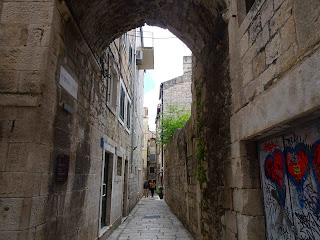After Zagreb, Phillip and I traveled south to the Croatian coast, first to Zadar for two nights and then to Split for another two. Of the two cities, we definitely prefer Split. I planned the stop in Zadar because the bus trip all the way to Split would have been seven hours, too long for a travel day. So, three and a half hours on two separate days instead. Zadar did have two unique art installations, the Sea Organ and the "Greeting the Sun" installation. The "Greeting the Sun" attraction was a large set of solar panels installed in the boardwalk that activated at night and changed colors. We saw the panels during the day, when they were absorbing energy, but not at night when they were colorful. Our hotel was over a km away and we weren't keen on being out late enough to see the color light show.
.JPG) |
| "Greeting the Sun" during the day as it absorbs solar energy |
We did hear the Sea Organ and spent over thirty minutes sitting on the seawall steps, waiting as passing boats made waves. The Sea Organ is a series of organ pipes drilled in the concrete under the water level. As water pushes in from waves, air is forced thru the organ, creating musical sounds. The higher the waves from the passing boats, the louder and more varied the music.
.JPG) |
| The sea wall steps had holes from which the music came |
Zadar had a fortress, but it wasn't picturesque as too many newer restaurants and shops were built next to the walls and within the fortress. The medieval and Roman castles and fortresses we've already seen were nicer.
.JPG) |
| Water wells inside the fortress, but notice the modern restaurant on the right |
The road from Zadar to Split ran right along the coast, so we saw beautiful water vistas from the bus window.
.JPG) |
| Numerous places along the bus ride where we saw islands |
Split was a larger city with a UNESCO World Heritage site, Diocletian's Palace. The Palace was built at the end of the third century AD as a retirement residence for the Roman emperor Diocletian. Diocletian was unique among Roman emperors because he actually retired. The Palace is one of the most famous and complete architectural and cultural features on the Croatian Adriatic coast. As the world's most complete remains of a Roman palace, it was designated a World Heritage site by UNESCO in 1979. Phillip and I viewed it from the coastal boardwalk on the evening we arrived, then walked thru it on our full day in Split.
.JPG) |
| One of the main gates into the Palace |
.JPG) |
| Walking thru the narrow streets of the Palace |
.JPG) |
| Some of the walls were older and still in ruin |
After walking thru the palace, we came out one of the northern passages and found a "train" tour that would take us thru the city, into Marjan Park, and to the city overlook. The "train" was a tractor-like vehicle pulling two covered trailers of seats. The Adriatic Sea views were similar to what we had seen on the bus ride, beautiful blue water. I enjoyed the mountain view as the Marjan Park road snaked up the side of the mountain to the overlook. .JPG) |
| Working our way to the top of this mountain. |
Note, if you can, the holes in the side of the mountain about midway. Built into clefts in the cliffs are a group of Renaissance hermitage caves, first used in the 15th century. We zig-zagged up the hill and saw a closer view..JPG) |
| A closer view of the hermitage caves used by monks over 500 years ago. |
.JPG) |
From near the overlook, this yucca flower stalk was bigger
in diameter than my wrist and resembled asparagus |
.JPG) |
| View of Split from the overlook, a Norwegian cruise ship at the port |
Although a cruise ship was docked in Split, we did not notice huge crowds. More vendors were set up near the palace and all the shops were open, but walking thru the Palace wasn't bad. We just turned down alleys to avoid tour groups. Tomorrow: we head for Mostar, Bosnia & Herzegovina. We have to transfer buses midway, and it will be our first non-Schengen border crossing of the trip. That means a passport stamp! Italy, Slovenia, and Croatia are part of the Schengen Zone with free borders with each other. There are no border stops when traveling between the member countries.
.JPG)
.JPG)
.JPG)
.JPG)
.JPG)
.JPG)
.JPG)
.JPG)
.JPG)
.JPG)
.JPG)
.JPG)
.JPG)
No comments:
Post a Comment